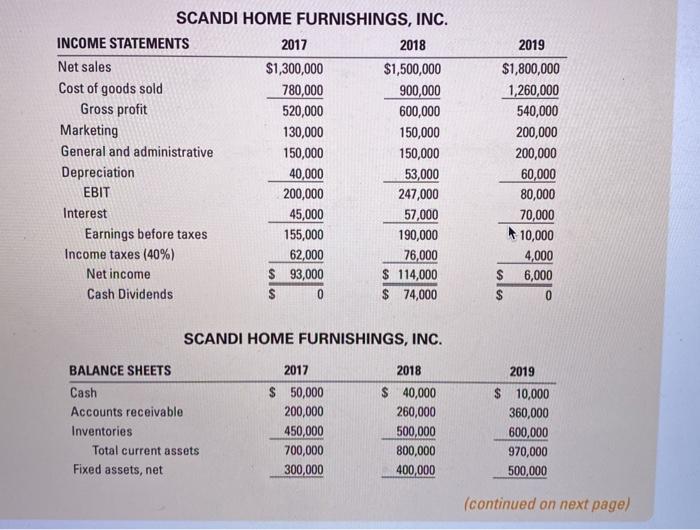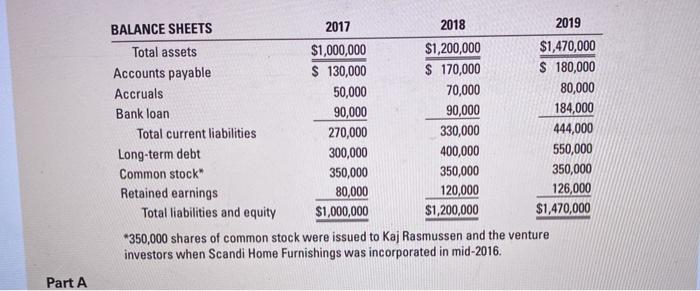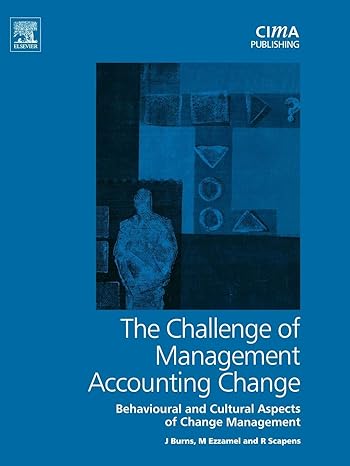Answered step by step
Verified Expert Solution
Question
1 Approved Answer
Kaj Rasmussen founded Scandi Home Furnishings as a corporation during mid-2016. Sales during the first full year (2017) of operation reached $1.3 million. Sales increased
Kaj Rasmussen founded Scandi Home Furnishings as a corporation during mid-2016. Sales during the first full year (2017) of operation reached $1.3 million. Sales increased by 15 percent in 2018 and another 20 percent in 2019. However, after increasing in 2018 over 2017, profits fell sharply in 2019, causing Kaj to wonder what was happening to his pride-and joy business venture. After all, Kaj worked as closely as possible to a 24/7 pace, beginning with the startup of Scandi and continuing through the first three full years of operation.
Scandi Home Furnishings, located in eastern North Carolina, designs, manufactures, and sells Scandinavian-designed furniture and accessories to home furnishings retailers. The modern Scandinavian design has a streamlined and uncluttered look. While this furniture style is primarily associated with Denmark, both Norwegian and Swedish designers have contributed to the allure of Scandinavian home furnishings. Some say that the inspiration for the Scandinavian design can be traced to the elegant curves of art nouveau from which designers were able to produce aesthetically pleasing, structurally strong modern furniture. Danish furnishings and the home furnishings produced by other Scandinavian countriesSweden, Norway, and Finlandare made using wood (primarily oak, maple, and ash), aluminum, steel, and high-grade plastics.
Kaj grew up in Copenhagen, Denmark, and received an undergraduate degree from a technical university in Sweden. As is typical in Europe, Kaj began his business career as an apprentice at a major home furnishings manufacturer in Copenhagen. After learning the trade, he quickly moved into a management position in the firm. However, after a few years, Kaj realized that what he really wanted to do was to start and operate his own Scandinavian home furnishings business. At the same time, after travelling throughout the world, he was sure that he wanted to be an entrepreneur in the United States. Kaj moved to the United States in early 2016. With $140,000 of his personal assets and $210,000 from venture investors, he began operations in mid-2016. Kaj, with a 40 percent ownership interest and industry-related management expertise, was allowed to operate the venture in a way that he thought was best for Scandi. Four years later, Kaj is sure he did the right thing.
Following are the three years of income statements and balance sheets for Scandi Home Furnishings. Kaj felt that he would need to continue to expand sales to maintain a competitive advantage. After first concentrating on selling Scan-dinavian home furnishings in the Northeast in 2017 and 2018, he decided to enter the West Coast market. An increase in expenses occurred associated with identifying, contacting, and selling to home furnishings retailers in California, Oregon, and Washington. Kaj Rasmussen hopes that you can help him better understand what has been happening to Scandi Home Furnishings from both operating and financial standpoints.



Step by Step Solution
There are 3 Steps involved in it
Step: 1

Get Instant Access to Expert-Tailored Solutions
See step-by-step solutions with expert insights and AI powered tools for academic success
Step: 2

Step: 3

Ace Your Homework with AI
Get the answers you need in no time with our AI-driven, step-by-step assistance
Get Started


